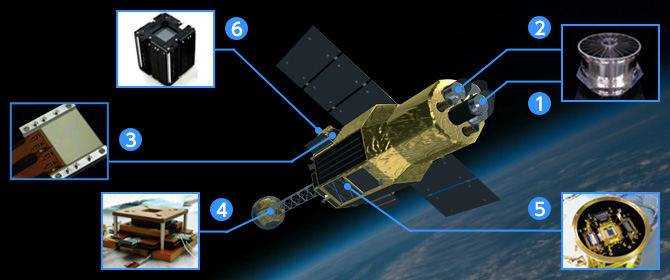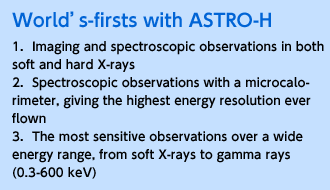

- Soft X-ray Telescope (SXT)

- Hard X-ray Telescope (HXT)
ASTRO-H carries two each of these two different kinds of telescopes. Hard X-rays are especially difficult to focus because of their high penetrating power, and the HXI is one of the first telescopes to be able to do this. This produces images on the detectors on the focal plane (SXI, HXI)

- Soft X-ray Imager (SXI)
The SXI will image X-rays in space with a wide field of view and moderately high energy resolution using a CCD camera, which is a product of Japan’s semiconductor industry.

- Hard X-ray Imager (HXI)
The HXI will enable imaging at higher energies, and the combination of SXI and HXI will give the first X-ray images over such a broad bandpass.

- Soft X-ray Spectrometer (SXS)
SXS is equipped with a microcalorimeter, which is a detector cooled to an extremely low absolute temperature of 50mK (millikelvin) , only fractions of a degree above absolute zero. Its remarkable energy resolution will make it possible to measure the dynamics of X-ray hot gas to unprecedented accuracy. Astro-H will make the worlds first X-ray astronomy observations with a microcalorimeter

- Soft Gamma-ray Detector (SGD)
The SGD is equipped with the most sensitive ever semiconductor Compton camera ever flown. It will measure soft gamma rays, which have shorter wavelengths than X-rays, to explore the effects of non-thermal particle acceleration in the universe.
| Scheduled Launch Date | 2015 |
|---|---|
| Launch Location | Tanegashima Space Center |
| Launch Vehicle | H-IIA |
| Overall Height | About 14m |
| Mass | About 2.7 tonnes |
| Orbit | Altitude 550 km, circular orbit |
| Objectives | To explore high energy phenomena such as black holes and supernova explosions. To research the structure and evolution of the universe by observing galaxy clusters filled with high-temperature gas. |
Discovering the Relationship Between Black Holes and Galaxy Formation | Probing the Evolution of the Universe with Galaxy Clusters | Hopes for New Images of the Universe | ASTRO-H Outline
Spin-off Technologies from ASTRO-H | History of Japanese X-ray Astronomy Satellites

